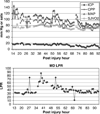Metabolic crisis without brain ischemia is common after traumatic brain injury: a combined microdialysis and positron emission tomography study
- PMID: 15716852
- PMCID: PMC4347944
- DOI: 10.1038/sj.jcbfm.9600073
Metabolic crisis without brain ischemia is common after traumatic brain injury: a combined microdialysis and positron emission tomography study
Abstract
Brain trauma is accompanied by regional alterations of brain metabolism, reduction in metabolic rates and possible energy crisis. We hypothesize that microdialysis markers of energy crisis are present during the critical period of intensive care despite the absence of brain ischemia. In all, 19 brain injury patients (mean GCS 6) underwent combined positron emission tomography (PET) for metabolism of glucose (CMRglu) and oxygen (CMRO(2)) and cerebral microdialysis (MD) at a mean time of 36 h after injury. Microdialysis values were compared with the regional mean PET values adjacent to the probe. Longitudinal MD data revealed a 25% incidence rate of metabolic crisis (elevated lactate/pyruvate ratio (LPR) > 40) but only a 2.4% incidence rate of ischemia. Positron emission tomography imaging revealed a 1% incidence of ischemia across all voxels as measured by oxygen extraction fraction (OEF) and cerebral venous oxygen content (CvO(2)). In the region of the MD probe, PET imaging revealed ischemia in a single patient despite increased LPR in other patients. Lactate/pyruvate ratio correlated negatively with CMRO(2) (P < 0.001), but not with OEF or CvO(2). Traumatic brain injury leads to a state of persistent metabolic crisis as reflected by abnormal cerebral microdialysis LPR that is not related to ischemia.
Figures




Similar articles
-
A combined microdialysis and FDG-PET study of glucose metabolism in head injury.Acta Neurochir (Wien). 2009 Jan;151(1):51-61; discussion 61. doi: 10.1007/s00701-008-0169-1. Epub 2008 Dec 20. Acta Neurochir (Wien). 2009. PMID: 19099177
-
Middle cerebral artery occlusion and reperfusion in primates monitored by microdialysis and sequential positron emission tomography.Stroke. 2001 Jul;32(7):1574-80. doi: 10.1161/01.str.32.7.1574. Stroke. 2001. PMID: 11441204
-
Glucose metabolism in traumatic brain injury: a combined microdialysis and [18F]-2-fluoro-2-deoxy-D-glucose-positron emission tomography (FDG-PET) study.Acta Neurochir Suppl. 2005;95:165-8. doi: 10.1007/3-211-32318-x_35. Acta Neurochir Suppl. 2005. PMID: 16463843 Clinical Trial.
-
[Use of intracerebral microdialysis in severe traumatic brain injury].No Shinkei Geka. 2010 Sep;38(9):795-809. No Shinkei Geka. 2010. PMID: 20864768 Review. Japanese.
-
Positron Emission Tomography After Ischemic Brain Injury: Current Challenges and Future Developments.Transl Stroke Res. 2020 Aug;11(4):628-642. doi: 10.1007/s12975-019-00765-0. Epub 2020 Jan 14. Transl Stroke Res. 2020. PMID: 31939060 Free PMC article. Review.
Cited by
-
Alterations in cerebral oxygen metabolism after traumatic brain injury in children.J Cereb Blood Flow Metab. 2013 Jan;33(1):48-52. doi: 10.1038/jcbfm.2012.130. Epub 2012 Sep 12. J Cereb Blood Flow Metab. 2013. PMID: 22968318 Free PMC article.
-
Red blood cell transfusion in the neurological ICU.Neurotherapeutics. 2012 Jan;9(1):56-64. doi: 10.1007/s13311-011-0094-5. Neurotherapeutics. 2012. PMID: 22203525 Free PMC article. Review.
-
Cerebral Microdialysis in Neurocritical Care.Curr Neurol Neurosci Rep. 2018 Oct 23;18(12):101. doi: 10.1007/s11910-018-0915-6. Curr Neurol Neurosci Rep. 2018. PMID: 30353361 Review.
-
Microdialysis-Assessed Adipose Tissue Metabolism, Circulating Cytokines and Outcome in Critical Illness.Metabolites. 2018 Oct 6;8(4):62. doi: 10.3390/metabo8040062. Metabolites. 2018. PMID: 30301230 Free PMC article.
-
A Precision Medicine Agenda in Traumatic Brain Injury.Front Pharmacol. 2022 Mar 16;13:713100. doi: 10.3389/fphar.2022.713100. eCollection 2022. Front Pharmacol. 2022. PMID: 35370671 Free PMC article. Review.
References
-
- Ackerman RH, Lev MH, Mackay BC, Katz PM, Babikian VL, Alpert NM. PET studies in acute stroke findings and relevance to therapy (abstract) J Cereb Blood Flow Metab. 1989;9(S1):S359.
-
- Andersen BJ, Maramarou A. Isolated stimulation of glycolysis following traumatic brain injury. In: Hoff JT, Betz AL, editors. Intracranial pressure VII. Berlin: Springer; 1989. pp. 575–580.
-
- Baker SP, O’Neill B, Haddon W, Jr, Long WB. The injury severity score: a method for describing patients with multiple injuries and evaluating emergency care. J Trauma. 1974;14:187–196. - PubMed
-
- Bergsneider MA, Hovda DA, Shalmon E, Kelly DF, Vespa PM, Martin NA, Phelps ME, McArthur DL, Caron MJ, Kraus JF, Becker DP. Cerebral hyperglycolysis following severe human traumatic brain injury: a positron emission tomography study. J Neurosurg. 1997;86:241–251. - PubMed
-
- Bergsneider M, Hovda DA, Lee SM, Kelly DF, McArthur DL, Vespa PM, Lee JH, Huang SC, Martin NA, Phelps ME, Becker DP. Dissociation of cerebral glucose metabolism and level of consciousness during the period of metabolic depression following human traumatic brain injury. J Neurotrauma. 2000;17:389–401. - PubMed
Publication types
MeSH terms
Substances
Grants and funding
LinkOut - more resources
Full Text Sources
Other Literature Sources
Medical

